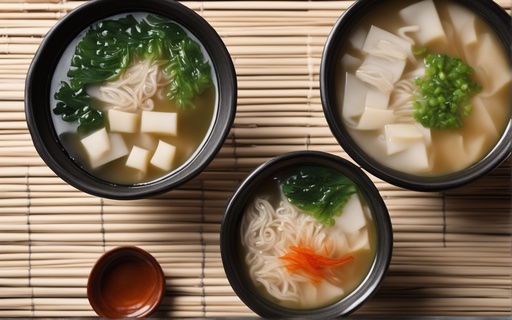Internet Asks: "Soybean Miso"
Soybean miso, often simply referred to as ‘miso,’ is a traditional Japanese seasoning produced through the fermentation of soybeans with salt and koji (the fungus Aspergillus oryzae). Sometimes, other ingredients like barley or rice are added to enhance its flavor profile. With its origins tracing back thousands of years, miso is deeply ingrained in the Japanese culinary landscape and has gained global recognition for its unique taste and nutritional benefits.
sponsored links

Historical Origins
Miso's roots trace back to ancient China and later Japan. Over the years, it underwent various transformations and refinements, resulting in the versatile and deeply valued product known today. Soybean miso remains one of the most venerated forms. Derived primarily from soybeans, this type of miso has a deeper, fuller flavor compared to its counterparts like rice or barley miso.
Types of Soybean Miso
-
- White Miso (Shiro Miso): This variant is made with a higher proportion of rice relative to soybeans, fermented for a shorter period, offering a lighter, sweeter flavor suitable for dressings and light soups.
-
- Red Miso (Aka Miso): Fermented for a longer duration with a higher soybean content, red miso has a deeper, saltier flavor, ideal for robust soups and marinades.
-
- Mixed Miso (Awase Miso): This type combines red and white miso, striking a balance between the sweetness of white miso and the umami of red miso.
How It’s Made
- 1. Soybean Preparation: Soybeans are soaked and cooked until they reach the appropriate consistency.
- 2. Koji Cultivation: Koji, a beneficial fungus, is introduced to the prepared soybeans or the grains. It aids in breaking down proteins and carbohydrates into amino acids and simpler sugars to initiate fermentation.
- 3. Fermentation: The mixture is allowed to ferment. This process, taking anywhere from a few months to years, results in the development of miso’s unique taste and texture. The longer it ferments, the richer and more intense the taste becomes.
- 4. Pasteurization & Packaging: Once the desired flavor and texture are achieved, the miso is pasteurized and packaged for distribution.
sponsored links
Nutritional Highlights
-
- Protein-Rich: Soybean miso is an excellent source of plant-based proteins, essential for muscle development and repair.
-
- Low in Fat: The majority of fats in soybean miso are healthy unsaturated fats.
-
- Diverse Minerals: It offers a variety of minerals, including manganese, zinc, and copper.
-
- Vitamins: It contains B vitamins which are crucial for energy production.
-
- Probiotics: As a fermented product, soybean miso is rich in probiotics which are beneficial for digestive health.
Culinary Uses
-
- Soup Base: Miso soup, a staple in Japanese cuisine, often employs soybean miso for a hearty flavor.
-
- Marinades and Sauces: Its rich umami flavor makes it a popular choice for marinades for fish, meat, and vegetables.
-
- Salad Dressings: Mixed with ingredients like sesame oil, vinegar, and honey, soybean miso can transform into a delightful salad dressing.
-
- Stir-fries: A touch of miso can elevate the flavors of a simple stir-fry.
Health Considerations
While soybean miso offers numerous health benefits, it is high in sodium, which means individuals with hypertension or those monitoring their sodium intake should consume it in moderation.
Additionally, always ensure it's added towards the end of the cooking process to preserve its probiotic benefits, as excessive heat can kill the beneficial bacteria.
Conclusion
Soybean miso, with its rich history, intricate production process, and diverse culinary applications, stands as a testament to the age-old fermentation traditions of East Asia. Its deep flavor, combined with its nutritional benefits, makes it a valuable addition to any kitchen. Whether you're crafting a traditional Japanese meal or seeking an umami-rich ingredient to elevate your dish, soybean miso is a worthy choice. However, like all foods, it should be consumed mindfully and in moderation.
Disclaimer:
This article is intended for informational purposes only. Consult a healthcare professional or a qualified nutritionist before making significant changes to your diet. Individual dietary needs and responses to foods vary, so the general information provided here may not apply to everyone.
sponsored links
References
1. Jetro. Miso/Soy Sauce. https://www.jetro.go.jp/en/trends/foods/ingredients/misoshoyu.html
2. Marukome. Origin and history of miso. https://www.marukome.co.jp/global/en/foodculture/aboutmiso/originandhistoryofmiso/
3. Messina MJ. Legumes and soybeans: overview of their nutritional profiles and health effects. Am J Clin Nutr. 1999 Sep;70(3 Suppl):439S-450S. doi: 10.1093/ajcn/70.3.439s. PMID: 10479216.
4. Kusumoto KI, Yamagata Y, Tazawa R, Kitagawa M, Kato T, Isobe K, Kashiwagi Y. Japanese Traditional Miso and Koji Making. J Fungi (Basel). 2021 Jul 20;7(7):579. doi: 10.3390/jof7070579. PMID: 34356958; PMCID: PMC8307815.
5. Britannica. Miso. https://www.britannica.com/topic/miso
6. Michelfelder AJ. Soy: a complete source of protein. Am Fam Physician. 2009 Jan 1;79(1):43-7. PMID: 19145965.
7. BBC Good Food. Miso Recipes. https://www.bbcgoodfood.com/recipes/collection/miso-recipes
People are also reading...
Seed Soybean
Is Tofu a Vegetable?
Tofu and Diabetes
Are Carrots Acidic?
Is Truvia the Same as Stevia?
Whole30 What to Expect?
Does Hot Chocolate Have Caffeine?
Are Carrots Acidic?
Are Mangoes Acidic?
Orange Juice pH?
Does Kahlua Have Caffeine?
Calories In a Grilled Cheese?
Ready to level-up?
Create meal plans 10x faster, follow up with your clients through our mobile app, and never struggle with meal planning or recipe management again.